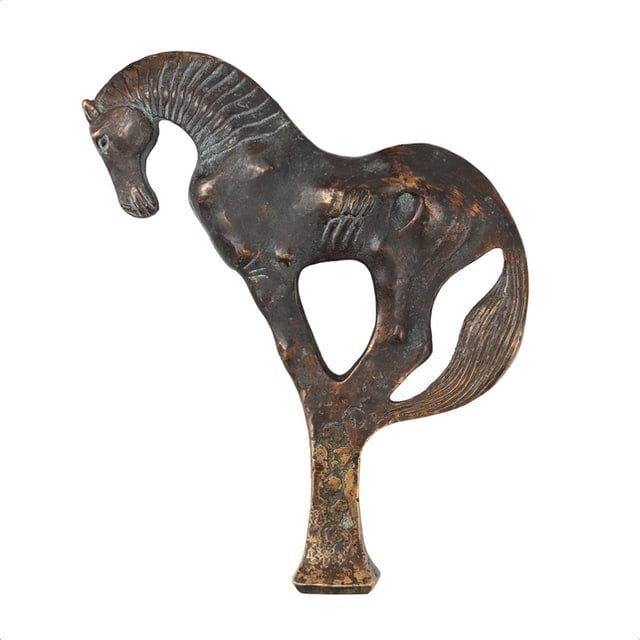What is the founder of the horse?

What is the founder of the horse?
As a horse owner, it will be helpful to have a basic understanding of the various components of a horse’s anatomy so that you can recognize red flags that may indicate illness, pain, or discomfort in your horse.
Its limbs are one of the most important parts of a horse’s skeleton. A horse with inflamed, injured, or otherwise disabled tendons, joints, or hooves is a critical condition that requires immediate medical attention as well as a slow and closely monitored recovery.
An established horse is also known as laminitis in the equine community and creates significant concerns about well-being for you as a horse owner. This article will discuss the symptoms, causes, diagnosis, treatment, and recovery of this condition.
What is the founder of the horse?
Let’s talk a little bit about the anatomy of the horse. In the structure of the lower foot of the horse, there are two basic bones: the navicular bone and the coffin bone.
The navicular bone is intended to provide cushion and flex for each horse’s stride. However, the coffin bone embeds itself in the horse’s hoof. Around it, there is a soft tissue, called the lamina, that helps attach this bone to the wall of the hoof.
The horse’s founder causes inflammation of this attachment layer or, in critical cases, leads to the disintegration of the surrounding soft tissues. Internally, this leads to excessive pressure with severe pain that follows.
Prevention is critical because a horse becomes vulnerable to a recurrence of the infection in the future once it is diagnosed with laminitis. Another thing to note is that this debilitating disease is incurable but is only dealt with with immediate and attentive care.
Marks of the founder of the horse
Just by looking at the outside of the hoof, you won’t be able to tell if a horse has laminitis (founder) or not. For this reason, it will be useful to know the typical red signs that you should pay attention to from this disease.
According to BlueCross, a British animal welfare charity, a horse, when standing, “may lean on its hind feet in order to rest its front feet.”
In addition, the horse may show some signs of lameness or its total weight may not weigh on the affected limb. The horse will lie down in the most serious cases and even refuse to get up.
In cases of acute founder horse, it is usual for the coffin bone to sink deep into the hoof capsule. Therefore, the diagnosis of a founder horse can be very disabling for the animal. In the worst case, a horse could suffer from hoof offspring with the possibility of the coffin bone penetrating the wall of the hoof.
Lauren Alderman, DVM, CVA, CVSMT, writes that a horse experiencing an “acute episode of laminitis [] may present with malaise, sweating, hyperventilation and an elevated heart rate.”
Types and Symptoms of Founder Horse
In general, there are two types of founder horse , visionary and chronic . Unfortunately, redistribution of weight from the affected leg to the supporting limbs can cause the founder of the supporting limbs .
Species
- Acute Founder: Symptoms usually appear suddenly and can be moderately severe. In these cases, the coffin bone and plate are separated from each other very painfully.
- Chronic Founder: Symptoms of the acute founder persist for more than three days. Once a horse has tolerated a relapse of a previous case of laminitis, it becomes chronic.
- Founder of the Supporting Limbs: Occurs when the healthy limbs are stressed due to the support of the horse’s extra weight.
symptoms
Although horse founder can occur in any of the feet of your horse, the disease is most common in the front of the animal. Some of the more common symptoms include:
- Walking with a kick in the heel
- Pedal bone movement (observable by a pair of trained hands)
- Showing grace to one side or the other
- It shows signs of tightness and obvious pain when moving
- Has a greater tendency to lie down
- refused to stand
- Will not raise the affected limb
- sudden limping
- The wall of the hoof can feel warm to the touch
The reasons for the founder of the horse
Believe it or not, one of the main causes of laminitis in horses is weight gain. Think about it: In general, a horse can weigh between 900 and 2,000 pounds, depending on its breed and purpose.
You don’t have to be a doctor to understand the exact nature of a horse’s limbs. Compared to the size and weight of a horse’s barrel and head, its legs are relatively small.
The primary function of a horse’s limbs is to lift its body and act as buffers during movement. So, while the fore and hind limbs function differently, the goal is the same.
As a horse owner, you should pay close attention to the condition of your horse’s limbs. Unfortunately, horses suffer from this painful disease at the hands of their owner’s negligence.
Often times, horses are overworked and required to pull loads that are up to their capacity. In other cases, improper diet and nutrition can be the cause of a painful and irreversible ordeal.
Other main reasons for the founder of the horse
- Working too hard or for a very long period of time
- Severe bacterial infections
- High fever or other illness
- Overfeeding grain (especially in barn environments)
- Lameness in one leg causes disease in the supporting limb
- Inexperienced trimming hooves
- Stressful situations such as travel and changing environments
- Pregnancy and childbearing
- Hormonal diseases such as Cushing’s disease or equine metabolic syndrome
- Other inflammatory-type disorders can also cause laminitis to flare up.
The diagnosis of the founder of the horse
As a horse owner, you likely already have a trusted and trusted equine vet you rely on for your horse’s medical care. However, if you notice any sign already discussed, feel free to pick up the phone right away.
Whether you have to arrange transportation for your horse’s medical visit or your vet has agreed to come to your property, you should have all of your horse’s medical history on file in an easily accessible location.
Your vet will quickly inform themselves (a new vet) or remind themselves of your horse’s vaccination and medical history when they begin to prepare to take their vitals.
In the equine veterinary field, vitals are an important part of screening and will naturally be comprehensive. In addition, a horse’s body temperature, height, weight, general condition of the body, behavior, apparent pain or levels of discomfort, and heart rates are key indicators that your vet will refer to later in further tests.
After a complete and thorough physical procedure, the real work of properly assessing and diagnosing the potential threat of laminitis begins. So your vet will likely need to take some x-rays to determine if there is any movement of the coffin bone.
If the laminitis is severe enough, an experienced vet will know almost immediately and may discard typical testing techniques such as the lameness check.
To test for a horse’s lameness, your vet will assess its shape and standing position. They may also try to move the horse’s limb, checking its range of motion.
Suppose your horse is still able to stand and move, even though it feels uncomfortable. In this case, the vet can also inject the affected limb with anesthetic medication and observe the horse as it trots. Then, depending on how the horse holds itself, a trained eye can tell if it has laminitis.
Veterinarians and equine riders alike understand the sensitive nature of feet well. Therefore, your vet may also use a hoof tester, “a device that can be used to apply gentle pressure to any spot on the area of a horse’s sole, toe, or heel.”
In addition to these procedures, your vet may also order complete diagnostic tests to check blood counts, insulin levels, bacteria levels, and more.
horse founder treatment
Although laminitis is not curable, it can be treated and managed with due care. Unfortunately, this disease should not be taken lightly either as a horse owner or as a vet in the field.
At the US National Library of Medicine, one study closely followed up on the unfavorable outcomes for horses diagnosed with founder horse. The results were very concerning, as they indicated that 247 horses were euthanized and another 13 dead (due to a host of other diseases) caused by a group of 591 horses diagnosed with laminitis.
However, successful founder horse treatment must begin with a clear understanding of what caused this in the beginning. For starters, though, your horse is in a lot of pain, so your vet will prescribe medication to control the pain.
The horse’s response to anti-inflammatory medications is critical. Therefore, you will want to provide your vet with updates, and they will make any appropriate changes to your medication and dosage depending on the stage and severity of your laminitis.
It may help if you move the affected horse to a smaller living area, but be sure not to isolate it. If your horse does not enjoy visual stimulation and contact with other horses, stress from society can make matters worse.
Your horse’s new living area should have deep mulch that matches the shape of its hoof when it digs. Additionally, ask your vet about the possibility of using horse paste, which provides frog support and helps prevent bacterial and fungal infections.
Cold therapy is often used and requires the horse’s feet to remain below 40 degrees Fahrenheit for a period recommended by the vet. The ice bucket challenge is also an excellent measure to take when noticing any signs of laminitis before the vet arrives.
Rest is crucial to any recovery. However, be sure not to encourage lameness to let the horse lie down. Instead, ask your veterinarian how best to support your horse’s physical and joint health during the recovery process.
Modified surgical treatment may be necessary in severe cases, necessitating an entirely different set of postoperative rehabilitation and recovery instructions.
Healing from the founder of the horse
As your horse recovers from laminitis, you should have a new appreciation for how important hoof care and diet management are. You’ll want to connect your farrier to your vet so they can agree on the best way to trim your horse’s hooves and outfit them with boots.
And just like managing weight for humans, you can’t go on a diet, lose a bunch of weight, and then go back to eating the same unhealthy way you did before the diet.
It would be helpful if you were constantly managing your horse’s diet, making adjustments as necessary. Remember, aim to feed your horse according to its breed and purpose.
In general, a horse should consume about 2% of its body weight in food. And it would be better if you gave a horse a relatively lower diet. Also, feeding less and more often is the best practice because it is very similar to a horse’s natural foraging pattern.
Pay close attention to seasonal and climatic changes that affect the richness of different forages. One tip is to “restrict access to fertile pastures, especially during the wet spring months.”
Also, if your horse is giving birth to a foal, beware that the mare does not have a retained placenta – if this is the case, contact your vet immediately, as this can lead to laminitis.
While laminitis is unpredictable and any member of Equus caballus can infect the species at any time, take care to follow precautions and heed your vet’s advice and recommendations to take an active role in your horse’s health and wellness.
Founder’s Final Thoughts
Laminitis can result from non-trophic factors such as a traumatic injury or resulting from another chronic disease; However, in most cases obesity, poor pasture management and eating regimen are to blame.
The health and life of your horse’s foot depends on how you manage its lifestyle. Be sure to discuss the suitability of your horse breed for the purpose for which it was intended.
Also, stay on top of different feeding and supplement options so that you can be sure to implement regular changes to your horse’s diet depending on seasonal changes, lack of pasture, as well as the horse’s age, weight and workload.



